#compared to the dozens of game developers and publishers
Explore tagged Tumblr posts
Text
The amount of people not buying a Switch 2 on launch gives me hope that there won't be any shortage/supply issues when it releases.
#nintendo#jacob blogs#everyones out here talking about how this console is going to sell over a million units the day it's released#like how?? if everyone's gonna basically boycott this next generation??#i mean i guess it would be worth it if it means the console drops $100 in the first year#idrc#im not a business owner#but ninty nickle and diming us over consoles hardware and software#is wayy more permissible in my eyes#compared to the dozens of game developers and publishers#that push for predatory microtransactions in unfinished games#and yearly releases of games with updated cosmetics and unecessary season passes
9 notes
·
View notes
Note
I apologise if you've already answered this, but I tried searching your blog and I'm unsure if you haven't or if it's another example of Tumblr's amazing search system.
I was talking with a friend recently about how much of a culture clash the Monk Class is compared to the rest of Dungeons & Dragons and was wondering if there is a coherent reason for their original inclusion. I'm aware that they're largely influenced by Shaolin monks as depicted in Hong Kong cinema in the 70's/80's as compared to the Sword and Sorcery stuff most of the rest of D&D takes influence from.
Basically, my question ultimately boils down to, "Is the Monk Class there purely because of an original player wanting to rule of cool their way into playing something wildly out of genre, or is there a stronger link between Sword and Sorcery and Hong Kong cinema that could have organically resulted in the Monk Class joining the rest of the classes?"
A lot of the link between the two was simply a matter of time and place. The kung fu craze hit North America at just about exactly the same time as the sword and sorcery revival that gave us films like Clash of the Titans and Beastmaster and The Sword and the Sorcerer and Dragonslayer and Krull – not to mention the Arnold Schwarzenegger Conan adaptation, which revived popular interest in first-wave sword and sorcery literature – so there was a lot of it going around. Analysis of early Dungeons & Dragons as a product of its media influences often overlooks that it was largely drawing on what was trendy in American popular media in the 1960s, 1970s and 1980s. Even the tonally incongruous Lord of the Rings references weren't a deep cut; while the books were originally published in the 1950s, they'd experienced a strong resurgence in the 1970s, putting them firmly in the popular consciousness at the time that D&D was being developed. All this being the case, it's not surprising that early D&D was also substantially influenced by Hong Kong action cinema.
That said, the reason the monk character class in particular (i.e., as opposed to kung fu media influences more generally) is there is allegedly because one specific guy in one of the game's early playtest groups really, really wanted to play as Remo Williams from Warren Murphy and Richard Sapir's The Destroyer; several of the class's signature abilities are direct references to powers Williams exhibits in the course of the novels. Remarks from folks who worked at TSR at the time have pointed the finger at Brian Blume as the Remo Williams fan in question, though accounts are conflicted whether Blume was actually an uncredited contributor to Dave Arneson's Blackmoor (1975), in which the class makes its first proper appearance, or whether Blume's interest merely prompted its inclusion.
This is the case for the character archetypes in a lot tabletop RPGs of that era; instead of trying to work out what classes "ought" be be present, authors would simply start with the types of characters their playtesters actually wanted to play, often based on specific popular media characters, then work backwards to derive an IC rationale for why those were the setting's standard adventuring professions. Other examples from D&D in particular most obviously include the Ranger (based on Tolkien's Aragon, naturally), but also the Paladin (principally inspired by Holger Carlsen from Poul Anderson's 1961 isekai novel Three Hearts and Three Lions, also the source of D&D's goofy regenerating trolls), the Assassin, back when it was still a separate character class (probably mainly based on the Assassin Caste from John Norman's Gor), and even the Wizard to a large extent (less Gandalf than you'd think: a large portion of D&D's iconic wizard spell list is lifted directly from the 1963 Vincent Price film The Raven).
(I often think that modern indie RPGs could benefit from reviving this approach. Like, fuck textual consistency – just pick half a dozen of your favourite popular media characters without regard for the compatibility of the source material and work backwards to explain why these six random assholes are your game's playable archetypes!)
#gaming#tabletop roleplaying#tabletop rpgs#dungeons & dragons#d&d#game design#history#worldbuilding#swearing
3K notes
·
View notes
Text
Writer Interview Game
Tagged by @gilded-glitter!! Kissing u
When did you start writing?
I remember getting pissed off about the writing choices in the Pokemon Anime when I was about 8 or 9, and I came to the realization that I could write my own story featuring my own Pokemon Trainer and handle the story the ✨right ✨ way (lol). From there I started filling up several dozen school composition notebooks until several years later I realized I could write on my ipod touch and save myself the trouble.
Are there different themes or genres you enjoy reading than what you write?
I'll read just about anything as long as it interests me, but I think the genre I enjoy least is sci-fi? I don't hate it, but it just doesn't have that strong enough of an appeal to me, though I do like when people get goofy with it (Doctor Who, some episodes of DS9, etc.) I love a good mystery/period piece though, and I while I enjoy writing it, whether or not I'm any good at it is another matter entirely. If there is a procedural detective show with a will-they-wont-they pair of leads, chances are I've seen it.
Is there a writer you want to emulate or get compared to often?
Oh jeez, well, I've never published fic before so I don't think I have ever been compared to anyone else, but an english teacher I had in high school once complimented me on have a "unique voice" in my writing, and I still think about it from time to time. As for writers I admire? Off the top of my head: Toni Morrison, Norman Maclean, Cormac McCarthy, and Tolkien.
Can you tell me a bit about your writing space? I write primarily on my phone, so I don't really have a dedicated space. I used Pages primarily but I kept running into issues with lag, so I recently switched over to Scrivener on my phone. As for where I write I either do so at my desk or in bed, or on long train rides. The good thing about writing on my phone is that if I have a sudden burst of inspiration and have the time, I can write almost anywhere.
What’s your most effective way to muster up a muse?
Music, especially with long train or car rides. Staring out the window at scenery with music often gets my imagination going. Long walks work too, especially if I'm on the treadmill at the gym and can zone out without worrying about walking into oncoming traffic lol. Other than that, ideas often come to me just as I am drifting off to sleep.
Are there any recurring themes in your writing? Do they surprise you?
Found family, prophecies, newfound/hidden powers, finding purpose, feeling like an outsider. These don't really surprise me, I was always kind of a weird kid and am now a weird adult, with the pervasive feeling of "not belonging" a constant throughout my youth. This isn't to say I don't have friends and family that I love, and am certain love me back, but I've always been a little awkward in most social settings, regardless of the context.
What is your reason for writing?
I have a very active imagination that probably borders on maladaptive dreaming, but writing and art create a healthier outlet to channel that into.
Is there any specific comment or type of comment you find particularly motivating?
Basically anything vaguely positive or encouraging is enough to make me blush.
How do you want to be thought about by your readers?
Honestly I don't even know, I hope they think I'm moderately cool? I have never been perceived through the lens of my writing before, only my art.
What do you feel is your greatest strength as a writer?
World building and character development!
How do you feel about your own writing?
Pretty shy, I am always mildly concerned that my stuff is too trope-y or whatever, and other times I re-read what I wrote and go "hey, that's pretty good!".
When you write, are you influenced by what others might enjoy reading, or do you write purely for yourself, or a mix of both?
I would say 99% of what I write is my own OC stuff that I never plan to make public, so I'd say I write mostly for myself. That being said, I do think people would enjoy certain aspects of my OC stuff, it's just way too jumbled for anyone but myself to make any sense of it at this point in time.
Tagging whoever wants to join in on this!
7 notes
·
View notes
Text
Sega Mega Drive - The Steel Empire
Title: The Steel Empire / 鋼鉄帝国
Developer/Publisher: HOT-B
Release date: 13 March 1992
Catalogue No.: T-28033
Genre: Horizontal Shooter

To blaze your way through Steel Empire from start to finish is an entertaining experience, if not a particularly repeatable one. It is perhaps worth playing through at least twice, to try each level with the two selectable aircraft, but undoubtedly you will settle on one as your favorite and stick with it against what hints in the level briefings otherwise suggest. I found the 'leveling-up' system for weapon enhancement to be restrictive compared to the half-dozen or so individual weapon sets available in most other shooters, but it certainly allows you to think less about which items to collect in the heat of battle. The ability to fire behind your craft makes for superior rear defense, and is a very useful feature handled well in Steel Empire. It is an enjoyable enough shooter with a unique feel, and (like many Mega Drive games of similar quality) worthwhile picking up if found for a sensible price, preferably single digit. Well done, HOT-B. Oh, and don't be bummed out by the fact the western version of this game on the Mega Drive is published by Flying Edge which is essentially Acclaim. Acclaim had nothing to do with this game apart from distributing it in western territories. It has also seen a mediocre port to the Game Boy Advance and far superior enhanced remakes on the Nintendo 3DS and Nintendo Switch.




youtube
2 notes
·
View notes
Text

That's official, I've signed with a publisher! 🎉
Who, why, and how? ⬇️
I think the most important thing to say first is that I retain the IP and complete control over the game design and development. They will definitely help, but can't force anything on me. I'm still creatively independent, and that's the important part.
I talked with dozens of publishers over the past year, discovered how they could help me, and compared their offers. @AstraLogical is one of the publishers who believed in me and my game. They have an awesome team, a unique vision, and exceptionally indie-friendly terms. I signed the contract without any doubts or fears, and I'm confident this is the right move (reviewed by a lawyer, of course). Kinda insane considering how stressful these last few weeks were.
I won't have to rush a stripped-down game release early this year because I'm running out of funds. The game will be much better thanks to the additional time and resources.
I can also stop worrying about marketing and focus on my game. It's going to reach way more people than if I were handling it all by myself. Astra is going to fund and handle the translation into tons of languages. They will also take care of quality assurance and testing.
I'm not alone anymore. Solo game development is hard and lonely. Having this team of passionate players helping me make this game a reality makes a HUGE difference.
I'm working on my next devlog. I want to share the whole process of finding a publisher, step by step, with tips and tricks to make this easier. Be sure to subcribe to my youtube channel to know when it's out. Don't hesitate if you have any questions. #gamedev
5 notes
·
View notes
Text
The Ultimate Guide to Image Converter Tools in 2025 Why SnapConv Stands Above the Rest
Picture this: You're rushing to meet a deadline, and suddenly you realize your presentation images are in the wrong format. Your client needs JPEGs, but you have PNGs. Your website requires WebP files for faster loading, but your designer sent you TIFF images. Sound familiar?
Welcome to the modern digital world, where image converter tools have become as essential as your morning coffee. But here's the thing – not all image converters are created equal, and choosing the wrong one can cost you precious time, money, and sometimes even your sanity.
What Exactly Is an Image Converter?
An image converter is a digital tool that transforms images from one file format to another without losing quality or compromising the visual integrity of your content. Think of it as a universal translator for your digital images – it speaks PNG, JPG, WebP, AVIF, and dozens of other "languages" that different platforms and applications require.
But here's where most people get it wrong: they think any free image converter online will do the job. That's like saying any car will get you from point A to point B – technically true, but the experience can vary dramatically.
The Hidden Cost of Choosing the Wrong Image Converter Online
Before we dive into what makes a great online image converter, let me share something that might surprise you. Last year, our team analyzed over 50 different image conversion tools, and the results were shocking:
73% of free converters added watermarks to converted files
61% required email registration for basic features
45% had severe file size limitations
38% actually reduced image quality during conversion
29% stored user files indefinitely (yes, your private images)
These aren't just numbers – they represent real frustrations that millions of users face daily when trying to convert images online.
Why Format Compatibility Matters More Than Ever in 2025
The digital landscape has evolved dramatically. What worked in 2020 simply doesn't cut it anymore. Here's why image format conversion has become mission-critical:
Web Performance Revolution: Google's Core Web Vitals now heavily penalize slow-loading websites. Converting images to modern formats like WebP or AVIF can reduce file sizes by up to 65% without quality loss.
Device Diversity Explosion: With smartphones, tablets, desktops, smart TVs, and IoT devices all displaying images differently, having the right format for each platform isn't optional – it's essential.
Storage Cost Reality: Cloud storage isn't free, and neither is bandwidth. Efficient image formats can cut your hosting costs significantly.
Accessibility Requirements: Modern web standards demand optimized images for users with slower internet connections or limited data plans.
The 25+ Formats That Actually Matter
While basic image converter online tools offer the usual suspects (JPG, PNG, GIF), professional workflows demand much more. Here's what you should look for:
Essential Web Formats:
WebP: Google's format that reduces file sizes by 25-35% compared to JPEG
AVIF: The newest format offering 50% better compression than JPEG
HEIC: Apple's efficient format (though compatibility can be tricky)
Professional Photography Formats:
RAW: For serious photo editing and maximum quality retention
TIFF: Industry standard for print and professional publishing
DNG: Adobe's open-source RAW format
Specialized Use Cases:
ICO: Essential for website favicons and application icons
SVG: Vector format perfect for logos and scalable graphics
EPS: Required for professional printing and vector work
PSD: Photoshop format preservation for advanced editing
Legacy and Niche Formats:
BMP: Still used in many enterprise applications
TGA: Gaming and 3D rendering industry standard
DDS: Texture files for game development
WBMP: Mobile applications (yes, still relevant)
What Makes SnapConv Different (And Why It Matters)
After testing dozens of image converter tools, I can honestly say that SnapConv represents what online conversion should be. Here's why:
No Compromise Philosophy: While competitors force you to choose between quality and convenience, SnapConv delivers both. No watermarks, no registration requirements, no file size limits that matter.
Format Depth: Supporting 25+ formats isn't just about quantity – it's about recognizing that different professionals have different needs. Web developers need WebP optimization, photographers need RAW conversion, designers need vector format support.
Processing Speed: Their cloud infrastructure automatically scales, meaning you get consistent performance whether you're converting one image or a hundred.
Privacy First: Files are processed and immediately deleted. No analysis, no storage, no data collection. In an era where privacy is increasingly precious, this approach is refreshing.
The Technical Side (Without the Boring Parts)
Here's what happens when you use a professional online image converter like SnapConv:
Smart Quality Preservation: Advanced algorithms analyze each image to determine the optimal conversion settings, maintaining visual quality while optimizing file size.
Metadata Handling: Depending on your needs, important information like camera settings or color profiles can be preserved or stripped for privacy.
Batch Processing: Real batch conversion that can handle multiple files simultaneously, not the fake "batch" processing that processes files one by one.
Error Recovery: Professional tools gracefully handle corrupted files or unusual formats instead of simply failing.
Real-World Use Cases That Prove the Value
E-commerce Optimization: An online retailer converted their product images from PNG to WebP using SnapConv, reducing page load times by 40% and increasing conversion rates by 12%.
Marketing Agency Efficiency: A digital agency cut their image preparation time by 75% using bulk conversion features, allowing designers to focus on creative work instead of technical tasks.
Photography Portfolio Success: A photographer converted RAW files to multiple web-optimized formats simultaneously, maintaining quality for print clients while optimizing for web galleries.
App Development Streamlining: A mobile app team used automated ICO generation for app icons across different platforms, ensuring consistency and saving hours of manual work.
The Free vs. Premium Converter Debate
Here's something most articles won't tell you: the best image converter tools are often completely free, but the worst ones pretend to be free while nickeling and diming you with limitations.
Red Flags to Avoid:
"Free with watermark" (not actually free)
Email required for download (your privacy is the payment)
File size limits under 5MB (practically useless)
Quality degradation (defeats the purpose)
Limited format support (forces you to use multiple tools)
What True Free Conversion Looks Like:
Unlimited file processing
No quality degradation
No registration requirements
Privacy protection
Comprehensive format support
SnapConv exemplifies this approach – truly free conversion without compromise.
Advanced Tips for Professional Image Conversion
Optimize for Purpose: Converting images isn't just about changing file extensions. For web use, consider quality vs. size tradeoffs. For print, prioritize quality retention.
Understand Color Profiles: When converting between formats, be aware of color space changes. RGB for digital, CMYK for print.
Batch Processing Strategy: Group similar images and convert them together with consistent settings for professional results.
Format-Specific Considerations:
JPG: Best for photographs with many colors
PNG: Ideal for images with transparency or few colors
WebP: Perfect balance for modern web use
SVG: Scalable graphics and logos
The Future of Image Conversion
The image conversion landscape is evolving rapidly. Here's what's coming:
AI-Enhanced Conversion: Machine learning algorithms that can upscale images while converting, improving quality beyond the original.
Real-Time Format Optimization: Tools that automatically detect the user's device and deliver the optimal format.
Advanced Compression: New formats that maintain quality while achieving unprecedented file size reductions.
Automated Workflow Integration: Conversion tools that integrate directly with content management systems and design workflows.
Security and Privacy in Image Conversion
This topic doesn't get enough attention, but it should. When you upload images to an online image converter, you're potentially sharing sensitive information. Consider these scenarios:
Business documents with confidential information
Personal photos with EXIF data containing location information
Product images before public launch
Legal documents or medical images
Professional conversion tools like SnapConv address these concerns by:
Processing files immediately without storage
Using HTTPS encryption for all transfers
Not analyzing or indexing uploaded content
Complying with international privacy standards
Making the Right Choice for Your Needs
Choosing the right image converter depends on your specific use case:
For Web Developers: Prioritize tools that support modern formats like WebP and AVIF, with batch processing capabilities for efficiency.
For Photographers: Look for RAW format support and quality preservation algorithms that maintain professional standards.
For Designers: Vector format support (SVG, EPS) and PSD compatibility are essential for workflow integration.
For Business Users: Privacy, reliability, and format versatility matter most for professional communications.
For Casual Users: Simplicity and universal format support without technical complexity.
Conclusion: Why Quality Matters in Image Conversion
In our rush to digitize everything, we sometimes forget that quality matters. Your images represent your brand, your memories, your professional work. They deserve better than a rushed conversion that degrades quality or compromises your privacy.
The best image converter online tools don't just change file formats – they preserve the integrity of your visual content while adapting it for its intended purpose. Whether you're optimizing for web performance, preparing for print, or ensuring compatibility across devices, the right tool makes all the difference.
SnapConv represents this philosophy in action – professional-grade conversion that's actually free, actually private, and actually designed for real-world use. In a market full of compromises, it's refreshing to find a tool that simply works the way it should.
Your images are important. Your time is valuable. Your privacy matters. Choose your image converter accordingly, and experience the difference that quality makes.
Ready to see what professional image conversion looks like? Try SnapConv free image converter today – no registration, no limitations, no compromises. Just the conversion results you deserve.
1 note
·
View note
Text
Interacty Review Appsumo Lifetime Deal $79
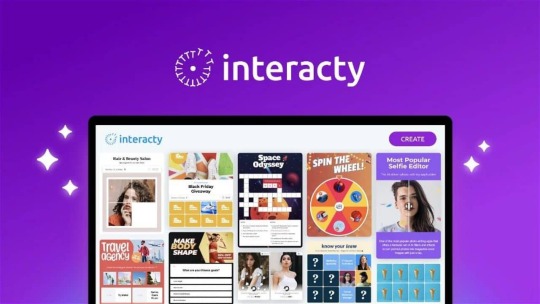
Interacty Review Appsumo Lifetime Deal $79: Unleash Potential!
If you're looking to make your content more engaging, then Interacty might be the solution for you. This gamification platform lets you create interactive content like quizzes and games for your website in minutes. And the best part? You can get it for a lifetime deal of just $79 on Appsumo!
What is Interacty?
Interacty is an interactive content and gamification platform. It allows you to create engaging content that encourages your audience to actively participate. Instead of just watching a video or reading an article, your audience can play games, take quizzes, and interact with your content in many other ways.
Types Of Interactive Content
Games
Quizzes
Slideshows
Interactive images
Timelines
Who Can Benefit from Interacty?
Many different people and businesses can benefit from using Interacty to create more engaging content.
Teachers And Educators
Teachers can use Interacty to create interactive lessons and gamify the learning process. This makes learning more fun and engaging for students.
Marketers And Production Agencies
Marketers can create branded games, contests, and giveaways to collect leads more efficiently. It's a great way to make marketing campaigns more engaging.
Publishers And Content Producers
Publishers, digital magazines, blog sites, and online news sources can use Interacty to make their content more engaging. This can help increase the time visitors spend on their sites.
Interacty Appsumo Lifetime Deal $79
How Does Interacty Work?
Using Interacty is simple. Here's a step-by-step guide on how it works:
Create
Creating a quiz or game takes just minutes with dozens of templates and ready-to-use blocks. You can build your interactive game in minutes using content blocks that can be fully customized with the design editor.
Share
Share or embed your interactive content on your website with a simple copy-paste. You can even get a QR code for easy sharing. If you need to make a change, you can update your content on the fly.
Play
Your audience can easily play your interactive content on desktop, mobile, tablet, or even via Zoom. Your project, your rules.
Collect Results
Add forms and leaderboards to collect results and reward the best among those who completed the task. This can help you gather valuable data and increase engagement.
Features of Interacty
Interacty is packed with features that make it a powerful tool for creating interactive content.
Interactive Activities
With over 20 interactive activities and countless combinations, you'll never run out of options. You can create quizzes, games, slideshows, timelines, and much more, all on a single platform.
Customization
Interacty's intuitive design editor lets you build your own interactive game with simple content blocks. You can add static elements like images, text, and YouTube videos to increase brand awareness via your games. You can also get access to thousands of royalty-free images via Unsplash or upload your own.
Lead Generation
Add lead forms to your games to collect customer information for sales and marketing. This is a great way to gather leads while keeping your audience engaged.
Live Games
You can play live games with your team, making meetings more fun and developing a sense of teamwork.
Integrations
Interacty integrates with several popular tools to make your workflow smoother.
Google Analytics
Google Tag Manager
Mailchimp
Webhooks
Best For
Interacty is best suited for content creators, educators, and marketers who want to make their content more engaging.
Alternative to
If you're looking for alternatives, Interacty can be compared to tools like Kahoot and LeadPages.
Get the Appsumo Lifetime Deal
You can get Interacty for a lifetime deal of just $79 on Appsumo. This is a fantastic offer considering the value you get from the platform. Don't miss out on this opportunity to make your content more engaging and collect more leads.
To grab this amazing deal, click here.
Frequently Asked Questions
What Is Interacty?
Interacty is a platform to create interactive content and gamification for websites.
How Much Does Interacty Cost On Appsumo?
Interacty is available for a lifetime deal of $79 on Appsumo.
What Types Of Interactive Content Can I Create?
You can create quizzes, games, slideshows, timelines, and more.
Who Can Benefit From Using Interacty?
Teachers, marketers, content creators, and event organizers can benefit from Interacty.
Conclusion
In conclusion, Interacty is a powerful gamification platform that lets you create interactive content to boost customer engagement and collect more leads. With its easy-to-use design editor, customizable templates, and numerous interactive activities, it's a must-have tool for anyone looking to make their content more engaging. And with the Appsumo lifetime deal for just $79, it's an offer you shouldn't miss!
Don't wait! Get your Interacty Appsumo lifetime deal now by clicking here.
0 notes
Text
Whales are bad but the average gamer isnt the same nowadays.
Whales are bad, but the average gamer isnt the same nowadays. It used to be that games stayed alive with whales pumping money in and keeping the game afloat for a lot of the little guys. Of course there were guppies nickel and diming here and there, but today the gaming landscape is far different than what it used to be. Modern gamers blame whales for the abundance of microtransactions, but the truth is, kids born after millennials grew up in a world only with microtransactions in their games. Fortnite set the gaming landscape ablaze with their then radical ideas on how to enable microtransactions in a game, and coupled with their marketing, this ushered in a major turning point in the annals of gaming. No longer are major publishers relying on the anticipation of grand DLC being teased, at least in most instances (exceptions being things like Elden Ring or Cyberpunk), to keep their game relevant. Microtransactions are thee status quo nowadays. And kids are fueling this just as much as the whales. Kids want stuff in game. They beg the parents, the parents make them do chores, it's a whole symbiotic relationship solely for the kid to 'own' digital assets. Take a look at Call of Duty compared to itself a decade ago, 2 decades ago? These microtransactions are selling like hotcakes, because kids place just as much value in digital assets as they do real world tangible things, whereas Millennials, and older, place a lot less value in digital things in comparison to real world things. We, the readers of this sub are mostly powerless against over-bearing, and often, predatory microtransactions. They sell. The gaming landscape is no longer a 'hobby' or 'niche' industry. It's a full blown corporate machine. Over the last decade there has been a major shift from competitive game development to profit driven development. It's gross, but it is the new normal. As a 36yo, ive almost never bought anything in game that was purely cosmetic, but CS cases dont count, right? See, where it fails a dozen times, microtransactions permeate even the most staunch of us after being repeatedly bashed over the head with it. This post, unfortunately, is less of a solution, and more an acknowledgement of the gaming landscape as a whole, but all we can do is continue to vote with our wallets and continue to only support game developers that support positivity in gaming. Submitted May 22, 2024 at 04:59PM by King_of_the_Dot https://ift.tt/JL5Ggc4 via /r/gaming
0 notes
Text
Greedfall
Developed by Spiders
Published by Focus Home Interactive
Release Date 2019
Tested on Xbox Series X (The game received Series and PS5 upgrade in 2021)
MSRP 34,99 USD
youtube
Surely you have played a game that put you in the role of ‘we put all our faith in you, as the main character, please don’t let us down’ before, you may say ‘doesn’t every game do that in a way?’, well Greedfall does it in a more straightforward way compared to what I am used to in other games. For example, as the main character you could be selected randomly as the saviour/hero in The Outer Worlds, or you can be this great commander with precise leadership skills with diplomacy and combat in Mass Effect series, the list goes on and on. In Greedfall, the story is set very precisely before you, you are a child of a wealthy family who is being sent to this recently-discovered and colonized island, Teer Fradee as a diplomat who is tasked to find a cure for the plague that has spread over your hometown and killed dozens of people so far in this 19th century central America setting. The people you interact with claim that there is rumour of cure in the island and natives might be acknowledged of it. This is the main focus so far, on top of this, you are required to keep the balance between multiple nations as a diplomat and interact them as main or side quests.
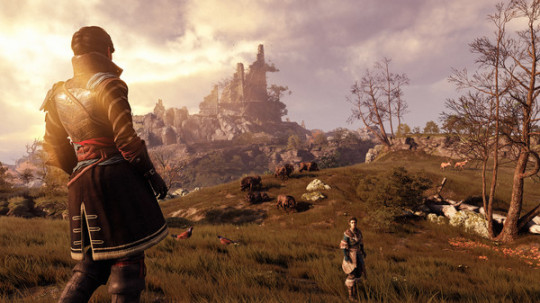
I would like to present my review in two sections, the reason behind this is the fact that the opening sequence lasts around 3 hours. Right at the beginning we are in our hometown island where a lethal plague, called malichor by locals, has spread and no cure has been found ever since. Before sailing away to the said island, we go through side missions. These side missions include finding a missing crew member of the ship that takes us to the island, looking for a young man who went missing last night after heavily drinking and partying in a tavern nearby, unveiling a pseudo-scientist’s fake potions. During all these quests I never said ‘ugh, let me play the actual game in this promised island, what are these missions?’, you get to know the world we’re in during these quests via interactions and it helps us understand why we are here, why we are going to this island unknown to us personally. This opening sequence might have bored some players because only one third of total players reached the island, Teer Fradee, meaning that around 70% of players did not even get to the point of playing main missions there (according to Xbox achievements). Not every player is ready to sink in at least 2 hours in an opening to be honest, when you ask a player to complete these set side quests before getting into the this mentioned island, you should make sure quests don’t take that long and they are engaging and setting groundwork for the island. Well, this opening could a hit and miss for some, for example our hometown is not that big and you will be running back and forth during quests and after an hour, it gets a bit repetitive and boring, the silver lining could have been a backstory or memorable NPCs at least. The focus is on plague, and there are corpses casually lying around, therefore I expected NPCs or side characters talk about their experience throughout this time, but the subject they talk about don’t really get into this plague at all. I mean, we just passed a corpse there, shouldn’t we give it a thought and point the elephant in the room? People are getting sick, getting worse, slowly dying, almost decaying and rotting, at least this is what we see when we interact with our mother, who looks almost hopeless and beyond repair. When a game takes a plague, virus or some sort of pandemic into the centre and build the story around it, naturally I anticipate memorable dialogue with the characters I come across. Instead of engaging moments, we chit-chat in a casual way and get on with it. In retrospect, this opening sequence feels like should have been shorter now that I played the game ‘on island’ and think that the opening does not inherently connect itself to our experience on Teer Fradee. When you set foot on the island, your character does not mention the hometown at all, at this point you see what you have done up to that point are not going to carry over, it is as if the developers built the game on Teer Frade, then added this opening as an introduction to the world but didn’t establish them on mutual ground.
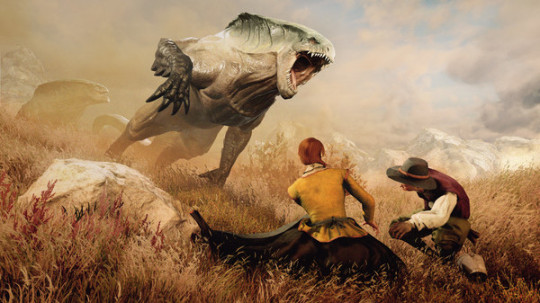
Budget of a game greatly impacts its development scope and time-window, I totally agree on that, still Greedfall really lacks variety in terms of interior designs, that I view as unacceptable at this point. Basically there are two interior designs when it comes to apartments and bigger spaces such as governmental buildings. Regardless of being in your hometown, Serene, or in Teer Fradee, interior designs are completely and 100% same layout and size-wise. You enter and apparently the living room welcomes you, you take the stairs to the above room, and here is bedroom. This is the complete house, is this really the final product or some draft version? It is extremely small and feels unnatural, who would design an apartment such as this? Even the stairs located in a weird way as if the rooms were created separately and put together on top of one another in the end. What sticks out the most is that, the first time you step into an apartment is where you investigate whereabouts of the missing crew member, and at the second floor the lady of the house boasts how wealthy they are. From the looks of size of this apartment, I am not convinced you are that rich, or you have a horrible taste in apartment designs. Whose living room is located right in front of the door? And it is so small that it looks like a cube with some tables, paintings and decorations added.
Here is the clip for small building interior design:
youtube
As for bigger places, a huge entrance welcomes you, at the end of the corridor you take stairs to the above floor which also has a massive empty open space, and you find the person to interact at the end of the room. Sadly, this is just a ‘bigger’ version of the apartment design, it is huge for sake of being huge, it does not create any sense of excitement or familiarity with it. Throughout your entire playtime, you will come across these two interior designs over and over again, I really wish the team had put more effort and energy into interior designs, because environmental design look cool and fresh, you can clearly see developers aspired to build an island, yet my appetite for interior designs isn’t satisfied at all. When I entered a location, I just wanted to interact with the required NPC and leave the place as soon as possible, I couldn’t stand with these terrible designs with bad taste, you cannot just simply stretch a location and have a huge corridor and put stairs randomly. This is not…a normal building, the humankind has never built or designed a building even closely resembling to this, ever.
Here is the clip for bigger spaces’ interior design:
youtube
The first cutscene cuts into the character customization screen, and there is a huge mistake here, and I am surprised, even shocked, to see that developers did not ‘fix’ this, am I the first person to report on this? The cutscene starts, a painter is drawing a person (this is us) and the person sitting on the stool is shown, then customization screen comes up, the ideal way would have been letting the player customise the character, then playing the cutscene. In this way the player would have felt like they are the main character here, not the pre-rendered male one. This looks amateurish to me.
youtube
The game presents you three playstyles, one firearms-focused, magic-focused and melee-focused, and accordingly the game recommends you to upgrade associated skills for the class you pick, at first the skill trees might confuse you a bit, because there are three separate skill trees, one for main classes, and the other two are extensions related to main class skills. You earn upgrade point each time you level up for main skill tree, and you earn upgrade points every other three levels for the other two skill trees. The thing is that, the game openly recommends you which skill or ability to unlock and upgrade, but it does not work like that actually, for example I picked magic-based class and I was upgrading the related skills, I learned and saw that I cannot do everything I wanted to do with these recommended skills. For example the game employs firearms, and you cannot use them if you don’t unlock the main skill, then I spend my points there, upgrade and improve it, even though the game presents three classes, you end up unlocking each ability and use them altogether, which eliminates classes in itself, my character is mainly using magic with a melee weapon as a second weapon and I use firearms when I am close to enemies. Of course, even when you unlock the main ability to equip firearms, there are certain weapons which will require to upgrade ability to use them. I am magic-based character, but I cannot equip magical rings unless I upgrade my skills. This skill trees and leveling them up seem a bit…complicated to me honestly, and this can be seen in the clips below, in the first one my character cannot jump because I need to upgrade to “vigor 2”. Am I really required to upgrade my skills to simply…jump? I accept that some skills or abilities locked behind abilities and the player should progress and achieve them over time, but we are talking about ‘jumping’ here, jumping is not something to be locked behind a skill. Same thing happened later in the game, and this one is even worse, where I thought I reached the main quest location to interact with somebody, but I couldn’t get across there, the game said I needed to upgrade my skill. It is frustrating to see the NPC right there but not being able to reach him! I had to take an alternative route to get to him which lasted around 7 minutes. I am asking this: should a developer be heavily invested in skill trees so much that it is creating roadblocks in front of the player? The answer is No. Just no. The player should feel to be encouraged to progress and improve his/her character, not blocked like that, for no rationale behind it.
youtube
youtube
I’d like to talk about the world-building a bit. So, the game tells us that this a recently discovered island, and there are natives living, and it is being still colonized by Americans. I came across a collectible, a letter, in the game and the letter mentioned that the island got discovered 5 years ago. At that moment I thought ‘wait a second, 5 years ago?’ the reason why I got shocked is that Americans built entire villages, roads, and cities throughout the island, and there is no way, it is impossible to build them in mere 5 years. This isn’t even believable one bit, I can safely say and claim that the cities and everything inbetween is at least half a century-old. First, nothing in this game looks fresh or new, buildings and towns look established and they are already old, there are numerous ruins in rural areas, there is no way to build these small castles near forests and leave them to rot in such a short time. If I disregard this detail, I would say I like world-building, you will visit different towns and cities though you would not find there much to optionally interact with anything or anybody. It is more like interacting with main quest NPCs and leave the town.
The NPCs might glitch time to time, from the looks of her, this lady is arguing with somebody invisible and still able to interact with us:
youtube
The game offers a fresh take on travelling from city to city, this is not an fully open-world game, meaning that you will fast-travel to areas when you would like to visit a city. You will come the edge of an invisible wall of the area you are in, and you will ‘travel’ and it will show you how long the journey will take, in the next screen you are able to buy or sell gear to the merchant, interact with your companions, and pick and remove from your current team, then continue your journey to the selected location. At first I was excited to see a game making use of time travel, and only one main quest makes use of time in game actually, other than that quest, I don’t see the point of time travel existing in this game. The quest in hand about a merchant who is being bullied by gangs and the merchant had to keep paying money for them otherwise it would have dire results for him, the merchant says ‘the gang will come back in 2 days, visit me then, and you will catch them’, during this game I was busy with other quests, and returned to the merchant in 48 hours, as he said the gang came back to bully him more, and we caught them there. Apart from this, you will not deal with game time at all, rendering it useless, a gimmick at best.
youtube
There is always a clever to keep the player’s attention hooked, and if you don’t succeed at this the quests will feel shallow, dull and void of meaning. Greedfall presents main and side quests in one of the worst ways I have ever seen. As you can see in the clip below, the quests don’t have any detail about the on-going mission, it is just ‘go there, do that, interact with this person’, if you stopped playing Greedfall and picked up a week later, you would totally fail to recollect what these quests were about. An on-going quest with different chapters or task within it should display a brief story of the quest from beginning, or show you the previous completed tasks. Due to this reason, I could not get into the quests that much, it always directs you to go somewhere and do something, the story does not help you that much because you are always this ‘I came here as a diplomat, please don’t bring me into your mess, but okay, whatever, I don’t have a choice’ type of person, what we do on this island is somewhat depends on other people and we are not making a difference here, I kept asking this ‘why are we sent here, on this island, do we have something unique to find the cure, why can’t anybody else do that?’, honestly I don’t have any idea what qualifies us as the person to find the cure to this plague.
In side quests you will see the top two quests, which require you to set up camps in each region and find a professor’s notes. Okay, this is not intuitive at all, as a player I dislike this approach because it is not creating an enjoyable experience for me. Throughout my playtime I casually and spontaneously set up camps in regions I explored, but I never got to find notes for the professor, what’s worse is that the game does not hint you where you can find them. Should I just pray and find them on my own in this gigantic world? Where should I even start to look for them? This is the way how you should not introduce players to side quests.
youtube
As I talked about in previous paragraphs, you will equip magic, melee weapons and firearms. The combat is satisfying and pleasant enough. In addition to real-time combat, you have the option to freeze the game and cast spells, use potions and fire your pistol, with this way you don’t feel the necessity to assign all of your potions and abilities as shortcuts.
youtube
With everything considered, the question has to be asked ‘I put 14 hours into this game, am I closer to finding the cure than I was at the beginning?’, it is appalling to recognise the story did not progress that much at all, for this reason I don’t see any point to continue the game, if the main goal of this journey is the cure and bring it back home, then why am I not seeing any progress on that despite 14-hour playtime?
Greedfall offers an average RPG experience with shortcomings with decent combat, it is not the whole package you might dream of, it is still unique in its own approach and treatment of character customization, world-building and narration.
0 notes
Text
Blacksmith of the Sand Kingdom is more fun than any 6/10 game that does everything ok but nothing great has any right to be
I'm going to attempt to get myself to post stuff here again even though I don't feel up to it most of the time, just so I don't forget my thoughts on things or forget how to write, and I guess we can start with this one because I just finished it over the past week.
Literally nothing in the game hasn't been done before dozens of times, frequently just as well if not better, but somehow it's still pretty satisfying anyway, and a lot of people who've tried to do those same things have managed to screw them up in ways that they avoided here.
The crafting system was just interesting enough to keep my attention until I finished the game, but it's nothing compared to an Atelier game.
The turn-based combat has a decent number of options available, but it doesn't give you much incentive to actually use most of them and doesn't stand out much in most ways (beyond how amazingly you can break it).
The music is kind of catchy and still stuck in my head, but beyond that it doesn't really stand out in any way.
Most of the art is serviceable and nice enough to look at, but the animations are kinda stiff and a lot of stuff is relatively generic. The character portraits are genuinely pretty good though.
The characters are pretty generic too, and you can guess exactly which stereotypes they fall into right away and be completely right, but they have just enough interactions with each other to make them mostly pretty likeable to spend time with them anyway.
And the story is just a big pile of tropes and cliches, but in a pretty inoffensive way that serves its purpose to move the game forward and be mildly rewarding when things get resolved.
Is it a great game? Absolutely not. Did I have a lot of fun with it anyway? Heck yeah!
It has a satisfying loop of doing quick runs of dungeons to collect materials, going back to town to talk to people and turn in quests, crafting a bunch of new stuff, selling the extras in your shop, and then repeating it all the next day. There's nothing revolutionary, and in a lot of ways it looks and feels like something from like 25 years ago, but they've managed to get rid of a lot of the rough edges a lot of games that actually came out back then tended to have, so there are very few barriers to just playing the game if you get into that loop.
I know Kemco has a reputation these days for publishing D-tier games that are low budget and not very good (and let's be real, the physical copy of Lagoon I still have for the SNES from when I was a kid tells me no one should be surprised that's what they do now because that's what they've always done), but there are some hidden gems in there, and this makes me curious about Rideon's (the developer's) other games. I guess I'll find out when Marenian Tavern Story: Patty and the Hungry God inevitably goes on sale again in the next few weeks.
Also since I can't be bothered to figure out where to edit it into this post higher up or make a separate one for it, here's something Blacksmith of the Sand Kingdom got right that much higher budget games that in theory should be much more polished surprisingly often don't: the way the menus feel.
Sure, they could've organized them a little better so you didn't need to dig through so many of them to do certain things like socket orbs into your gear, but they're quick and responsive and have options for filtering and sorting what's in them too. You can also scroll them one line at a time or an entire page at a time, when a surprising number of games don't bother with the latter.
And the real thing they got right that way too many games don't is that they're nearly instantaneous. I think it was World of Final Fantasy (definitely a Squenix game I played in the past year or so anyway) where the menus take a second or two to open up and become interactable, which is mildly annoying itself but made so much worse by the menu and cursor being drawn to the screen right away but not becoming responsive until that second or two is up. It's super obnoxious to visually indicate that you can do stuff when you can't do stuff yet, and I had to train myself over the course of the game to wait before pushing any buttons every time I opened the menu.
Something that's somewhere in between the two is Xenoblade Chronicles 3, where I'm pretty sure the menus take about the same amount of time to open, but the animation of them fading in is used to partially hide that, and more importantly they don't draw the cursor until it's already ready. As soon as it looks like you can interact with it you actually can for real, which feels infinitely better.
Anyway, that's the kind of thing that tons of AAA games manage to screw up that Blacksmith of the Sand Kingdom largely avoids. It also mostly manages to avoid doing anything truly great, but just not having tons of little common annoyances goes a long way because they add up.
Blacksmith of the Sand Kingdom: it's ok! And sometimes that's enough.
0 notes
Text
Yuri Expert Erica Friedman Dives Into LGBTQ Anime & Manga History in New Book 'By Your Side' – June 2022
In February, Yuri researcher and trend-setter Erica Friedman announced that they are writing a new book, By Your Side: The First 100 Years of Yuri Manga & Anime. The book will be published by Journey Press in June 2022, in time for pride month and the 20th anniversary of Okazu, the world's oldest and most comprehensive site on lesbian anime and manga.
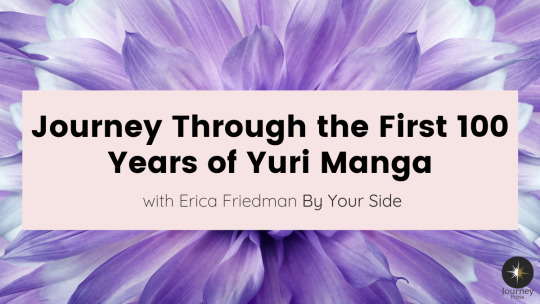
The term "Yuri" began life as a coded reference to lesbianism within manga and anime genre, but in the past few decades, fans, creators, and publishers shaped the term into a beautiful genre of its own. Friedman traces the past, present, and future of the genre, all the way from the modern Yuri phenomenon manga, webcomics, novels, and games to its routes over a century ago in Yoshiya Nobuko's pioneering works. Walk together through the past, present, and future of Yuri in this insightful and entertaining new work.
By Your Side is a collection of interlocking essays, articles, and essays from Friedman's gloriously hilarious, witty, and unwieldable mind. Through these essays, readers will become familiar with many of the Yuri genre's greatest creators, tropes, concepts, symbols, and titles. As the title suggests, the series focuses on the first 100 years of lesbian anime and manga, 1919-2019.
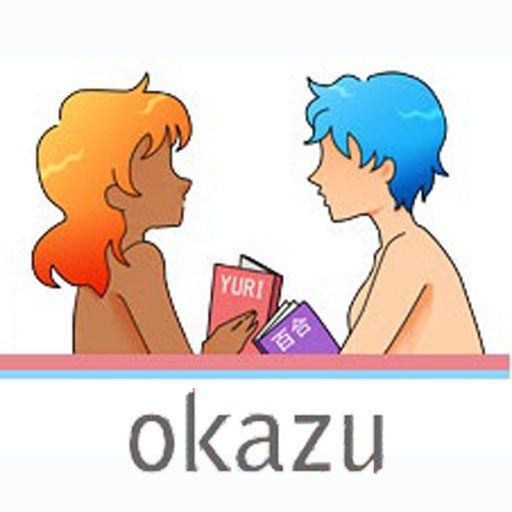
Friedman describes her hopes for the book to YuriMother:
I want people to approach it like joining me at a Yuri panel - as an ongoing, casual discussion of a topic we love to talk about! I want to walk by your side as we wander through a garden full of lilies and chat about the changes we've seen in Yuri... I hope folks will pick it up and read a section, then put it down and think about that series, or person, or concept, then come back later and read another section!
Because the chapters in BYS are sourced from my writings and presentations, BYS can be used by fans of Yuri who want to know more about the history of the genre and by students of pop culture who are looking for research they can use for their own work.
We also spoke about the future of Yuri.
So much has changed in the past even 20 years, I can hardly project what we haven't even imagined yet. ^_^
But...the thing that is the most exciting change I've seen recently and the thing I hope for the most is creators modeling worlds where queer lives and happiness are normalized...creators imagining joy in queer lives in Yuri.

Indeed, the past few years have seen wonderous titles from a variety of creators embracing Yuri's queer identity to tell both joyful and brutally real Yuri stories. Works like My Lesbian Experience with Loneliness, Yuri Life, and most recently, I'm in Love with the Villainess come to mind.
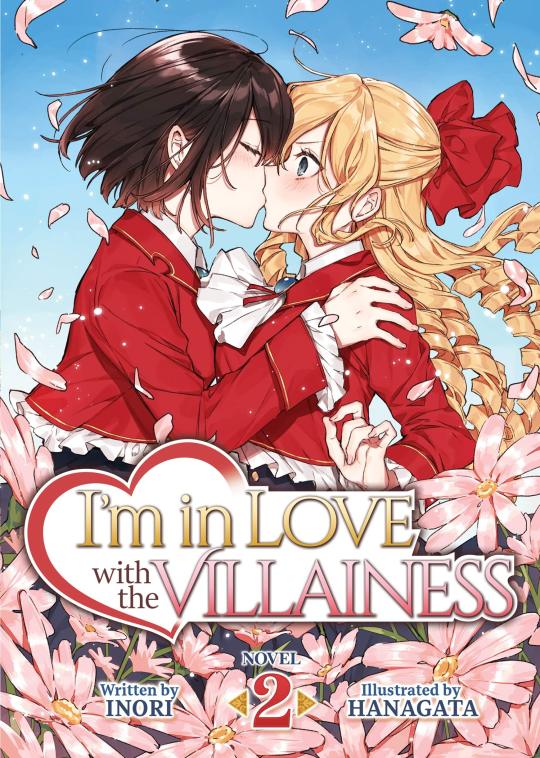
Friedman continues:
We spent a lot of time in the last century performing lesbian trauma for Yuri subplots. I'm looking forward to Yuri manga where lesbian couples just are and then the story happens.
They went on to express their excitement over finally getting ready to put out their "Big Book o'Yuri."
I'm very excited that the Big Book o'Yuri will be a reality, obviously. ^_^ And I'm delighted to be able to work with Journey Press on this. I know they'll give us all the best book they can make. We're probably going to run a Kickstarter, which will give us a chance to develop fun physical and digital goods, as well! And, when the pandemic is over, I absolutely want to do events at bookstores where I can talk to folks about their experiences with Yuri!
I'm also just exceptionally happy that there will be a book about Yuri out there. Right now we collect every essay we can on the Yuricon Essays page to help folks trying to do research (YuriMother is proud to have contributed works to this Essays page). Once this book is out, my wish is that we'll see more Yuri research being published as well. I look forward to reviewing other books about Yuri.
Just you wait, Erica Friedman! You blaze the trail, and YuriMother (which is to say I, the writer of this report) will happily follow in your footsteps! Readers, join me in supporting By Your Side when it is released next year and continue to consume and learn about Yuri!

Erica holds a Masters Degree in Library Science and a B.A. in Comparative Literature and is a full-time researcher for a Fortune 100 company. She has lectured at dozens of conventions and presented at film festivals, notably the San Francisco Lesbian and Gay Film Festival and the London Lesbian and Gay Film Festival. She has participated in an academic lecture series at MIT, University of Illinois, University of Michigan, Michigan State University, Harvard University, Kanagawa University, and others.
She has edited manga for JManga, Seven Seas, and Udon Entertainment, most recently Riyoko Ikeda’s epic historical classic, The Rose of Versailles.
Erica has written about Yuri for Japanese literary journal Eureka, Animerica magazine, the Comic Book Legal Defense Fund, Dark Horse, and contributed to Forbes, Slate, Huffington Post, Hooded Utilitarian, and The Mary Sue online. She has written news and event reports, interviews Yuri creators, and reviews Yuri anime, manga, and related media on her blog Okazu since 2002.
They were the founder of ALC Publishing, the first English publisher to release English Yuri manga. ALC Publishing passed the torch to new publishers in 2013 and no long publishes material.
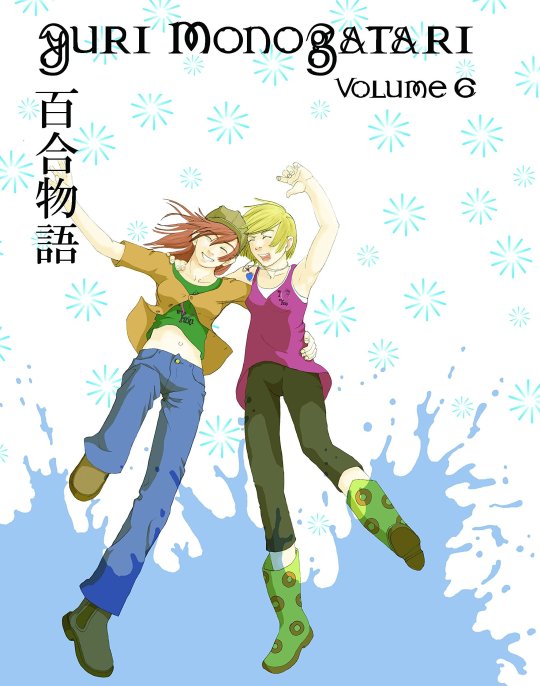
Journey Press was born in 2019 with the goal of bringing unusual and diverse science fiction to the forefront of the publishing landscape. We are dedicated to supporting the women and queer people who have been erased from the history books, and to the reprinting of worthy novels that fell by the wayside, in addition to publishing new novels by creators of all types.
#Yuri#lgbt#lgbtq#history#pride#anime#manga#queer#gay#wlw#girls love#gl#lesbian#yuricon#learning#education#queer history#lgbt history#news
423 notes
·
View notes
Link
I hit the breaking point as a parent a few years ago. It was the week of my extended family’s annual gathering in August, and we were struggling with assorted crises. My parents were aging; my wife and I were straining under the chaos of young children; my sister was bracing to prepare her preteens for bullying, sex and cyberstalking. Sure enough, one night all the tensions boiled over. At dinner, I noticed my nephew texting under the table. I knew I shouldn’t say anything, but I couldn’t help myself and asked him to stop. Ka-boom! My sister snapped at me to not discipline her child. My dad pointed out that my girls were the ones balancing spoons on their noses. My mom said none of the grandchildren had manners. Within minutes, everyone had fled to separate corners. Later, my dad called me to his bedside. There was a palpable sense of fear I couldn’t remember hearing before. “Our family’s falling apart,” he said. “No it’s not,” I said instinctively. “It’s stronger than ever.” But lying in bed afterward, I began to wonder: Was he right? What is the secret sauce that holds a family together? What are the ingredients that make some families effective, resilient, happy? It turns out to be an astonishingly good time to ask that question. The last few years have seen stunning breakthroughs in knowledge about how to make families, along with other groups, work more effectively. Myth-shattering research has reshaped our understanding of dinnertime, discipline and difficult conversations. Trendsetting programs from Silicon Valley and the military have introduced techniques for making teams function better. The only problem: most of that knowledge remains ghettoized in these subcultures, hidden from the parents who need it most. I spent the last few years trying to uncover that information, meeting families, scholars and experts ranging from peace negotiators to online game designers to Warren Buffett’s bankers. After a while, a surprising theme emerged. The single most important thing you can do for your family may be the simplest of all: develop a strong family narrative. I first heard this idea from Marshall Duke, a colorful psychologist at Emory University. In the mid-1990s, Dr. Duke was asked to help explore myth and ritual in American families.“There was a lot of research at the time into the dissipation of the family,” he told me at his home in suburban Atlanta. “But we were more interested in what families could do to counteract those forces.” Around that time, Dr. Duke’s wife, Sara, a psychologist who works with children with learning disabilities, noticed something about her students.“The ones who know a lot about their families tend to do better when they face challenges,” she said. Her husband was intrigued, and along with a colleague, Robyn Fivush, set out to test her hypothesis. They developed a measure called the “Do You Know?” scale that asked children to answer 20 questions. Examples included: Do you know where your grandparents grew up? Do you know where your mom and dad went to high school? Do you know where your parents met? Do you know an illness or something really terrible that happened in your family? Do you know the story of your birth? Dr. Duke and Dr. Fivush asked those questions of four dozen families in the summer of 2001, and taped several of their dinner table conversations. They then compared the children’s results to a battery of psychological tests the children had taken, and reached an overwhelming conclusion. The more children knew about their family’s history, the stronger their sense of control over their lives, the higher their self-esteem and the more successfully they believed their families functioned. The “Do You Know?” scale turned out to be the best single predictor of children’s emotional health and happiness. “We were blown away,” Dr. Duke said. And then something unexpected happened. Two months later was Sept. 11. As citizens, Dr. Duke and Dr. Fivush were horrified like everyone else, but as psychologists, they knew they had been given a rare opportunity: though the families they studied had not been directly affected by the events, all the children had experienced the same national trauma at the same time. The researchers went back and reassessed the children.“Once again,” Dr. Duke said, “the ones who knew more about their families proved to be more resilient, meaning they could moderate the effects of stress.” Why does knowing where your grandmother went to school help a child overcome something as minor as a skinned knee or as major as a terrorist attack? “The answers have to do with a child’s sense of being part of a larger family,” Dr. Duke said. Psychologists have found that every family has a unifying narrative, he explained, and those narratives take one of three shapes. First, the ascending family narrative: “Son, when we came to this country, we had nothing. Our family worked. We opened a store. Your grandfather went to high school. Your father went to college. And now you. ...” Second is the descending narrative: “Sweetheart, we used to have it all. Then we lost everything.” “The most healthful narrative,” Dr. Duke continued, “is the third one. It’s called the oscillating family narrative: ‘Dear, let me tell you, we’ve had ups and downs in our family. We built a family business. Your grandfather was a pillar of the community. Your mother was on the board of the hospital. But we also had setbacks. You had an uncle who was once arrested. We had a house burn down. Your father lost a job. But no matter what happened, we always stuck together as a family.’ ” Dr. Duke said that children who have the most self-confidence have what he and Dr. Fivush call a strong “intergenerational self.” They know they belong to something bigger than themselves. Leaders in other fields have found similar results. Many groups use what sociologists call sense-making, the building of a narrative that explains what the group is about. Jim Collins, a management expert and author of “Good to Great,” told me that successful human enterprises of any kind, from companies to countries, go out of their way to capture their core identity. In Mr. Collins’s terms, they “preserve core, while stimulating progress.” The same applies to families, he said. Mr. Collins recommended that families create a mission statement similar to the ones companies and other organizations use to identify their core values. The military has also found that teaching recruits about the history of their service increases their camaraderie and ability to bond more closely with their unit.Cmdr. David G. Smith is the chairman of the department of leadership, ethics and law at the Naval Academy and an expert in unit cohesion, the Pentagon’s term for group morale. Until recently, the military taught unit cohesion by “dehumanizing” individuals, Commander Smith said. Think of the bullying drill sergeants in “Full Metal Jacket” or “An Officer and a Gentleman.” But these days the military spends more time building up identity through communal activities. At the Naval Academy, Commander Smith advises graduating seniors to take incoming freshmen (or plebes) on history-building exercises, like going to the cemetery to pay tribute to the first naval aviator or visiting the original B-1 aircraft on display on campus. Dr. Duke recommended that parents pursue similar activities with their children. Any number of occasions work to convey this sense of history: holidays, vacations, big family get-togethers, even a ride to the mall. The hokier the family’s tradition, he said, the more likely it is to be passed down. He mentioned his family’s custom of hiding frozen turkeys and canned pumpkin in the bushes during Thanksgiving so grandchildren would have to “hunt for their supper,” like the Pilgrims. “These traditions become part of your family,” Dr. Duke said. Decades of research have shown that most happy families communicate effectively. But talking doesn’t mean simply “talking through problems,” as important as that is. Talking also means telling a positive story about yourselves. When faced with a challenge, happy families, like happy people, just add a new chapter to their life story that shows them overcoming the hardship. This skill is particularly important for children, whose identity tends to get locked in during adolescence. The bottom line: if you want a happier family, create, refine and retell the story of your family’s positive moments and your ability to bounce back from the difficult ones. That act alone may increase the odds that your family will thrive for many generations to come.
- Bruce Feiler. Emphases added.
125 notes
·
View notes
Text
Sega Saturn - Rockman X3 (Mega Man X3)
Title: Rockman X3 / ロックマン X3
Developer/Publisher: Capcom
Release date: 26 April 1996
Catalogue No.: T-1210G
Genre: Run-N-Gun Platform Action
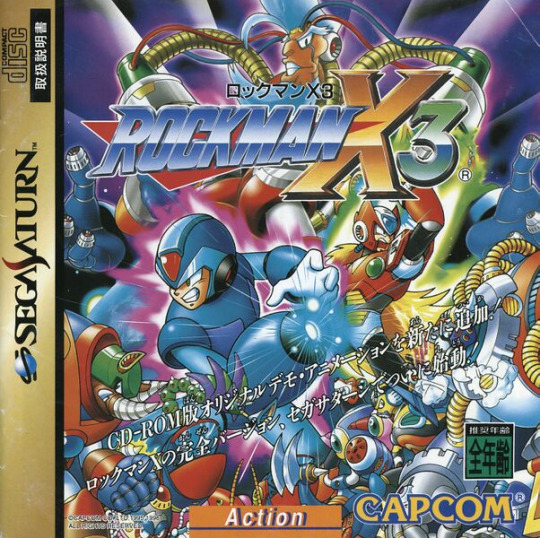
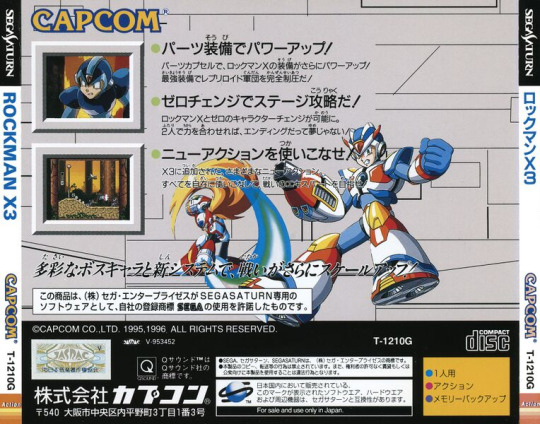
Rockman X3 is in fact a conversion of the Super Famicom original (and by extension the Mega Drive bootleg which I will get into), and it shows. Compared to Rockman X4, this game looks so dated. The graphics are bland, the animation isn't as good and the whole game runs in a stupid box with borders down the right and left sides of the screen. Saying that though, so did the Mega Drive bootleg version. If you must have a Rockman game for your Saturn, then I'd buy Rockman X4 or even 8 over this.
Rant over, I'll get into it as a standalone game. Bear in mind I played the Super Famicom version first. Rockman X3 is a great little game that requires all kinds of manual dexterity, thinking, and a great deal of patience. On its own, it's a real winner. Unfortunately, it's slightly different enough for the first baker's dozens of Rockman games to set it apart. Still, it's a good game and if you've already played the rest, you owe it to yourself to play this one as well. Being that the Saturn version is on a disc, you get some anime sequences and arranged CD music.
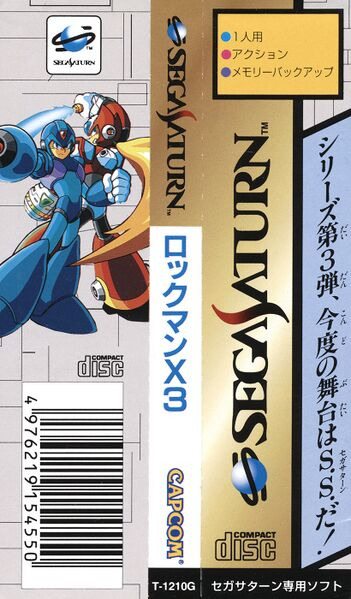
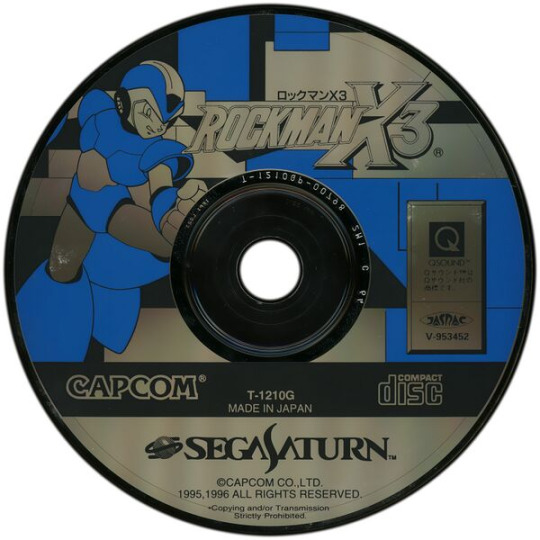

youtube
4 notes
·
View notes
Text
Big Games, Big Numbers
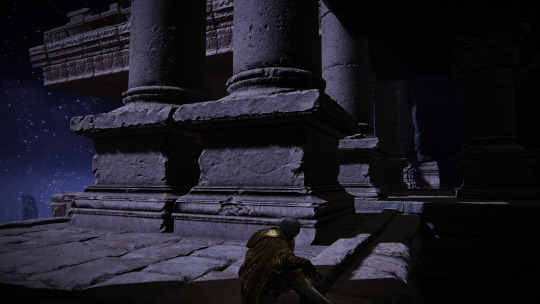
With it being a few months since its date of release, Elden Ring I think presents an opportunity to focus attention again on the industry of videogame reviews (as distinct from its industry of journalism; the two are not the same), and how, even after all the things it has gone through, it still very rarely prioritizes a comprehensive critical capacity over the need to praise the thing expected to receive praise and find fault with the thing expected to receive fault-finding. In other words, the videogame review industry continues to exist essentially as one big advertisement, and a partial consequence of this is that reviews are beholden to the arbitrary timeframe of the week of a game’s release.
What this meant with the case of Elden Ring (and other games of comparable size/duration) was that very few of the people appraising it actually finished it; in fact, it is doubtful that the majority got even, say, two-thirds of the way through. It took me playing a frankly unhealthy amount of hours of Elden Ring every other day for about a month-and-a-half to finish it; so what are we to expect of people whose job puts them on an even tighter schedule?
(Regarding videogames themselves, I would also note, comparatively, how events such as E3 impose a similarly arbitrary timeframe for “product presentability” upon each developer. The sooner these events die out, the better.)
If any of you have read some of my previous writings on Elden Ring -- here, here, and here -- you will know that my interest here is not neutral; but I believe that makes my concern more relevant than not. Over time, I experienced a dramatic turnaround of feelings and thoughts for the game, which ended as a knot of unpleasant exhaustion.
It is demonstrably untrue that anyone who finished the game within a similar timeframe would share my experience; but it is true that the triumphal celebration of Elden Ring’s exceptionally high scoring rests upon the tacit acceptance of dozens of viewpoints which are significantly experientially partial. Think of if a two-thousand page book was published, and 90% of its reviewers read eight-hundred of those pages and then awarded the book the highest of marks. Critically absurd -- and its normalization within videogame culture seems to depend, in part, upon the strange idea that, if you enjoy a videogame within its first quarter, you’ll enjoy it for as long as it continues.
A healthier critical practice for videogame reviewers -- among a host of other restructurings -- would be for them to note how much they played (Polygon’s review does cite an investment of forty-five hours); but as long as outlets mostly exist as advertorial supplements, reinforcing this or that trend, such transparency will also mostly be inadmissible.
What’s additionally worth point out here is that the matter of finishing, or just progressing through, Elden Ring intersected not only with its size but also its challenge. From a “practical” point of view, this means that the majority of people reviewing the game probably were called to review it precisely because they had finished prior games by FromSoftware -- because they are “Souls veterans”, or whatever, and would have a higher likelihood of both making headway and saying the “right things” to an established audience. Reassure people that the difficulty is still there, that a bunch of stuff is still obtuse, that the narrative still requires piecing together, that there is still a lot of equipment to choose from, etc., etc.
How boring.
Mightn’t it have been more interesting if the task of reviewing the game were instead given to people perhaps unfamiliar with FromSoftware’s titles, seeing as how the game has mostly been presented as an alternative take on the “open world” mold, and how much it has sold (implying a large number of first-timers)? Why not explicitly use that as an opportunity to see how people who might otherwise only know of that mold through the output of Ubisoft or Rockstar Games took to Elden Ring’s variations? Well, again, because that doesn’t make sense within the advertorial, preaching-to-the-choir, release-accompanying (or release-anticipating!) model reviews employ.
Although it escapes my level of attention now, I strongly believe that responsible critical interest herein will behoove future explorations of why Elden Ring may be receiving extra-special attention for its “open world” when, for example, Dark Souls was really a type of “open world” game too -- a type more particularly suited to the strengths of FromSoftware’s creative vision and still rare to find among 3D videogames (especially during a playthrough with the Master Key, which allows access to most locked doors). Between all of these highly positive reviews, I detect the dreary sentiment that, now that FromSoftware has “finally” paired certain design trademarks with a more recognizably “open world” format, it has achieved an ultimate formulation of potential -- a formulation that just happens to coincide with, as I wrote before, “a demand for Maximum Content.”
18 notes
·
View notes
Note
Ah man I'm so glad you made that post about ski resorts and racism, I never see content about the effects of ski resorts on the land. Keeping jumbo wild was a huge W and I was so glad to see it, and I hope it puts pressure on the people trying to push zincton through. I actually haven't heard much abt the zincton project lately, do you know of any updates? Thanks again for the content, so rarely hear other voices online from the inland temperate rainforest
Hey, thank you so much for the message. I know you’re also a fan of the region. Glad you saw that post and said something to me. :)
Yes, there has been some new media coverage of Zincton as of November 2020. And can I use this as an opportunity to say a couple of things about this rainforest? Sorry in advance for rambling and all of this text.
Right? The downfall of the Jumbo project was uplifting. Ski resorts obviously (like many “parks” in US and Canada) involve Indigenous dispossession and obscuring/erasure of histories and lives. (Details from that article: US sky resort visitors are 88% white, and half make over $100 thousand a year.) As for voices from the inland temperate rainforest: Gotta mention that the province of BC goes to such great lengths to silence the voices of the Sinixt people, declared “extinct” by the Canadian government and whose traditional territory includes much of the inland temperate rainforest (between 2016 and 2020, BC has fought against the Sinixt and their request for recognition, appealing every ruling, culminating in an October 2020 Supreme Court hearing). BC institutions like to claim the inland temperate rainforest as a “treasure” or “prize”, a “globally-unqiue” ecosystem, as a sort of entitlement or patrimony; meanwhile, the province of BC legally fights the Sinixt in court, ignores the caribou extinction, and still issues dozens of logging/timber and clear-cut contracts in the inland temperate rainforest each year. That said, the end of Jumbo was good news.
For anyone unfamiliar: Jumbo was a ski resort mega-development project planned for the Purcell Wilderness on Ktunaxa traditional territory right in the heart of the inland temperate rainforest region of interior so-called British Columbia, in old-growth cedar-hemlock forest, on the edge of glaciers, and in the middle of key habitat of southern mountain caribou, grizzly, wolverine, mountain lion, lynx, wolf, elk, mountain goat, marten, fisher, etc. The Glacier Resorts-owned project would’ve been “the single largest ski resort in North America” including a “resort base” of at least 110 hectares, a hotel with over 5,500 beds, and an expectation of over 3,000 visitors a day. The Ktunaxa had opposed the project since 1991, and took a case to federal Supreme Court. In January 2020, the Ktunaxa were able to buy-out the project, and the Jumbo area will now be managed as a formal Indigenous Protected Area.
The new Zincton resort is also being built on Ktunaxa and Sinixt land, about 70 kilometers away from the former Jumbo resort site.

Traditional territories:
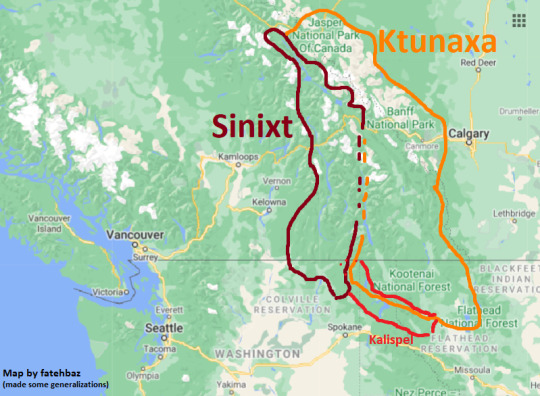
And yes, there are some updates on Zincton from November 2020.
@moss-effect -- I know that you already know this stuff. But for anyone unfamiliar:
The Zincton resort is being constructed only about 70-ish kilometers or so away from where the Jumbo resort was planned. Zincton is also on Ktunaxa territory, as well as traditional land of the Sinixt. Zincton (being built near Valhalla and Goat Range, between Naksup and Kaslo) expects a “grand opening” in December 2021. The project is run by the owner/founder of a local outfitter/recreation company. As of November 2020, BC’s Mountain Resorts Branch is still reviewing the owner’s formal proposal. Zincton sits closer to even more extensive old-growth forest and major protected areas.
Zincton also seems to be a manifestation of that now-classic category: “progressive” settler-colonial entrepreneurs from coastal BC, the Pacific Northwest, and/or Rocky Mountain West are familiar with local rhetoric and therefore elude criticism by rebranding their extractive and development projects as “eco-friendly”. According to The Narwhal (November 2020) the owner/project leader had this to say about the project: “There is a real story here of a proven disruptor facing down the mob to do one last project for the kids and grandkids. … Jobs for locals, a future for families, saving the hospital. Zincton is the Tesla of the ski village business.”
-------
Also, for context: Here’s a post I made about the inland temperate rainforest, its ecology/geography, and its endemic creatures. Here’s a post from June 2020 about the Zincton resort development. Here’s a compilation post with news/timeline/summary and maps describing the extinction of southern mountain caribou in 2019 (southern mountain caribou are a local icon, completely endemic to this region, and are highly endangered; caribou were declared extinct in the contiguous United States in 2019 when the last of the southern mountain caribou were relocated farther north to BC). Here’s a compilation post with news/timeline following the Sinixt case to receive formal recognition from BC/Canada in 2019 and 2020 (much of the rainforest, including the Zincton site, is within Sinixt traditional territory; the Canadian government declared the Sinixt “extinct” in the 1950s).
-------
Location of core cedar-hemlock forest of inland temperate rainforest region, compared with distribution range of the southern mountain caribou:

Photos I took of stream habitat in inland temperate rainforest:
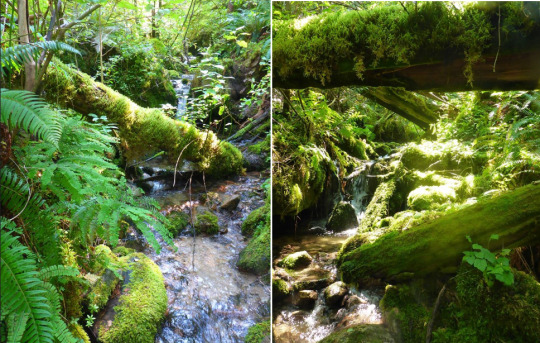
-------
Coincidentally, just a couple of days ago, The Narwhal just released an “explainer” dedicated to the Zincton: Paul Fischer. “Why B.C.’s Zincton resort, the proposed ‘Tesla of ski villages,’ is worrying conservationists.” The Narwhal. 27 November 2020.
Zincton claims that it is a “radical departure from the status quo” and will be a “carbon-zero” resort. But local groups oppose the project, including Wildsight, West Kootenay Eco Society, and locally-famous Valhalla Wilderness Society. (The core of the inland temperate rainforest is sometimes referred to as “Valhalla” or “Caribou Rainforest”.) The project also claims that the resort’s focus on so-called “eco-tourism” is a good way to “grow and replace economic decline,” which you might perceive to be a settler-colonial interpretation of the “value” of the forest and also suggests that the concern here is, of course, making money. From Fischer’s article: ‘In a series of emails with The Narwhal, Harley [the project leader] dismissed environmental concerns. He said impacted grizzly habitats are low quality and categorized the criticism from certain environmental groups as a “copy and paste” campaign motivated by a desire to oppose everything rather than contribute constructively.’
These quotes can be found in the article:







-------
Here’s some other stuff:


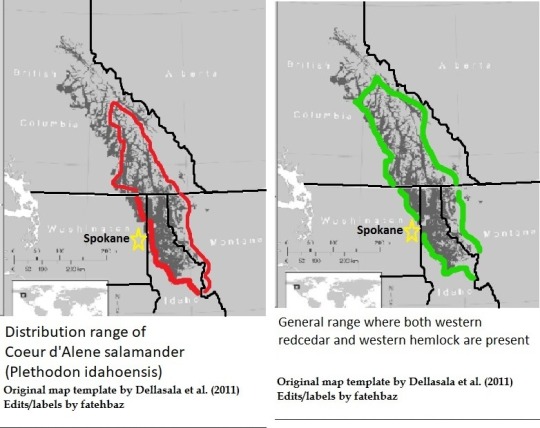
-------
Headlines from the Jumbo resort news:
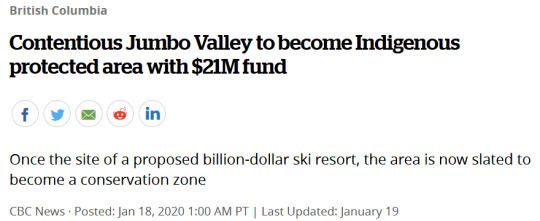

The Sinixt case:
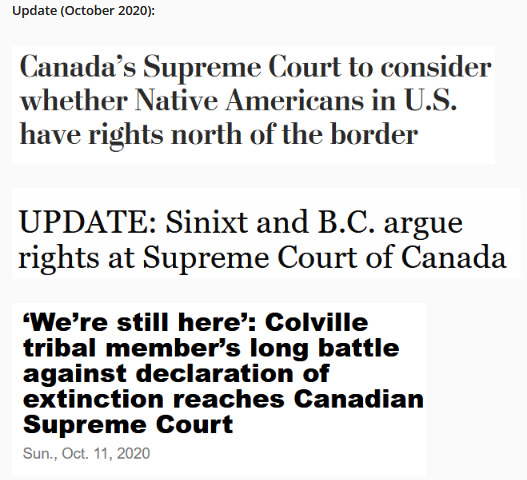
Southern mountain caribou herd decline in the inland temperate rainforest between 1990 and 2018. The Zincton resort will directly affect Purcells South, Central Selkirks, and South Selkirks herd.
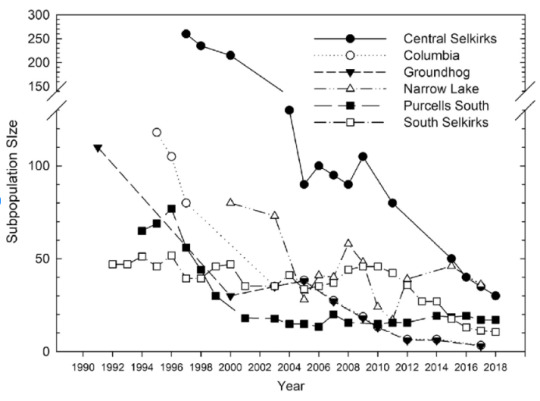

-------
And I want to say that both the Ktunaxa and Sinixt people have recently been undermined, insulted, and dispossessed by BC and development projects in similar ways. Media, educational material, and conservation groups in BC like to point out that the inland temperate rainforest is “globally-unique” (in that it’s really the planet’s only sizable “coastal-type temperate rainforest” existing inland and away from a coast). And you’ll see the inland temperate rainforest described with terms like: prized, treasure, gem, hidden/secret rainforest, etc. And the region is discussed in settler-colonial terms/concepts (”BC’s forgotten rainforest,” “BC’s other rainforest”, “a magnificent carbon cache”, “unparalleled resource”) as if it is the patrimony of the province of BC or Canadian state. Which of course is problematic because it (1) associates the forest’s importance with bioprospecting/scientific extractivism, carbon sequestration, or other metrics of settler-colonial “value,” and also because (2) the province of BC continues to fight very hard against recognizing the land as part of Sinixt territory (after Sinixt people and allies were able to win cases against BC, the province continued to appeal, and this case has now culminated in the October 2020 hearing at the federal Supreme Court, which will soon make a final ruling on whether or not Sinixt people are legally allowed land rights to harvest, travel, etc. within BC).
-------
Here’s a map:
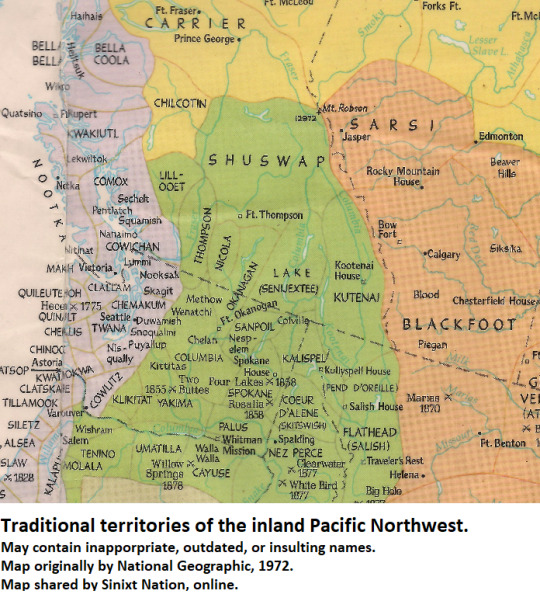
From 2018, there is this book:

In the US, too, parks, like ski resorts, are implicated in Indigenous dispossession.
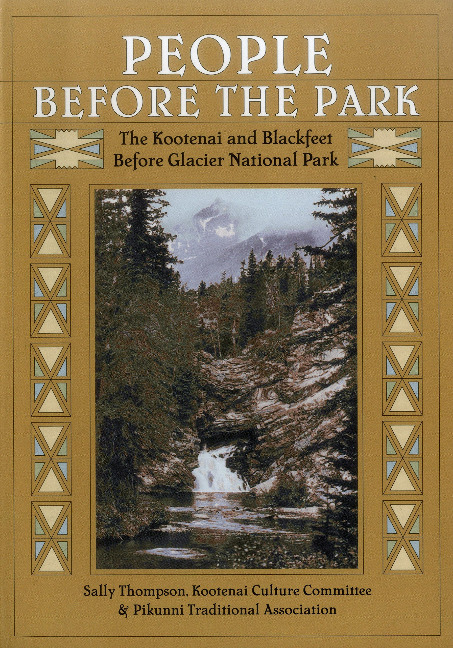
Glacier National Park (at the border of BC, Alberta, and Montana) sits on the edge of the Kootenay and inland temperate rainforest regions. Conservation groups, universities, and other US institutions have taken to calling Glacier part of “the Crown of the Continent” (another possessive/patrimonial term maybe?), a portion of the heavily-glaciated Canadian Rockies that kinda includes Banff and Jasper, too. Glacier National Park is on Ktunaxa and Blackfeet territory. A recently published book that might be interesting: People Before the Park: The Kootenai and Blackfeet Before Glacier National Park. Sally Thompson, Kootenai Cultural Committee, and Piikuni Traditional Association. 2015
Described by Montana Public Radio in 2017: “Step [...] into the world of the Kootenai and Blackfeet peoples, whose traditional territories included the area that is now Glacier National Park. [...] In this book, the Kootenai and Blackfeet tribes share their traditions -- stories and legends, foodways and hunting techniques, games and spiritual beliefs.”
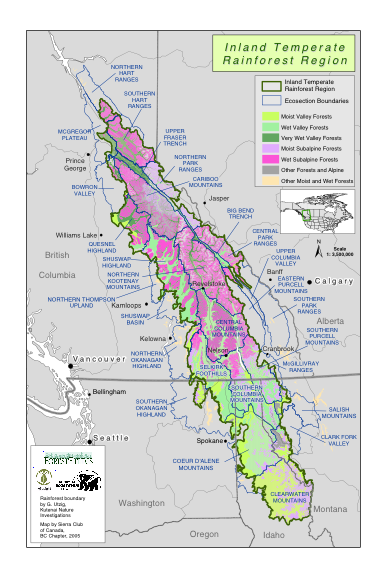
Just a special place.
Thank you for saying something.
292 notes
·
View notes